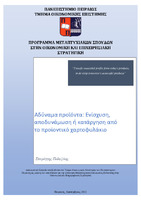| dc.contributor.advisor | Πολλάλης, Ιωάννης | |
| dc.contributor.author | Σπαράγγης, Πολυζώης | |
| dc.date.accessioned | 2022-10-03T05:03:10Z | |
| dc.date.available | 2022-10-03T05:03:10Z | |
| dc.date.issued | 2022-09 | |
| dc.identifier.uri | https://dione.lib.unipi.gr/xmlui/handle/unipi/14641 | |
| dc.identifier.uri | http://dx.doi.org/10.26267/unipi_dione/2064 | |
| dc.description.abstract | Η παρούσα εργασία πραγματεύεται την αξιολόγηση της κατάστασης ενός προϊόντος που βρίσκεται σε δυσμενή θέση, δίνοντας παράλληλα γενικές μεθόδους ανάκαμψής του, εφόσον τελικά διαπιστωθεί ότι τη δεδομένη στιγμή αυτό είναι προς το συμφέρον της εταιρείας. Έτσι, απαρτίζεται από τέσσερα διακριτά μέρη: Αρχικά, παρουσιάζεται μία πρώτη ανάλυση του εξωτερικού περιβάλλοντος της εταιρείας, τόσο του μακροπεριβάλλοντος όπου δραστηριοποιείται, δηλαδή της χώρας, με τα συγκεκριμένα χαρακτηριστικά που τη διακρίνουν, όσο και του μικροπεριβάλλοντός της, δηλαδή του κλάδου όπου δρα εκείνη και οι ανταγωνιστές της. Στη συνέχεια, αναλύονται τα χαρακτηριστικά και η δυναμική που μπορεί να έχει ένα προϊόν από τη σκοπιά της επιχειρησιακής στρατηγικής και των λόγων ύπαρξής του στο προϊοντικό χαρτοφυλάκιο της εταιρίας, με έμφαση στα χαρακτηριστικά του και στον τρόπο προώθησής του στην αγορά, εστιάζοντας στα προϊόντα που έχουν προβληματική διαχείριση και ως εκ τούτου χρήζουν ειδικής αντιμετώπισης. Προχωρώντας ένα βήμα πιο πέρα, προτείνονται μεθοδολογίες διαχείρισης μίας τέτοιας αρνητικής κατάστασης, με επιθυμητό στόχο την αντιστροφή των συνθηκών και την επανατοποθέτηση του προϊόντος στο δρόμο της κατά το δυνατόν μακροπρόθεσμης κερδοφορίας. Από την άλλη, γίνεται και μία οικονομική προσέγγιση, ούτως ώστε να αποτυπωθεί μετρήσιμα η κατάστασή του υπό εξέταση στοιχείου και η συμβολή του στο πλάνο της εταιρείας με το κέρδος ή τις ζημίες που προκύπτουν. Τέλος, παρατίθενται τρεις μελέτες περιπτώσεων πραγματικών εταιρειών όπου περιγράφεται η πορεία και οι λόγοι που τις οδήγησαν να αξιολογούν την κατάργηση ενός προϊόντος τους, καθώς και οι πιθανές κινήσεις και προσπάθειες που έκαναν για να το αναζωογονήσουν, και κατά πόσο αυτές απέδωσαν. Κλείνοντας, δομείται και ένα σύνολο απλών αυτοερωτήσεων, με σκοπό να βοηθήσουν τον αναγνώστη-στέλεχος εταιρείας που πιθανώς διαβάζει την εν λόγω έρευνα να συνειδητοποιήσει καλύτερα και πιο απλά την κατάσταση του προϊόντος που τον ενδιαφέρει αλλά και τις δράσεις που είναι ωφέλιμο να αναλάβει για να βελτιώσει τη θέση του. | el |
| dc.format.extent | 93 | el |
| dc.language.iso | el | el |
| dc.publisher | Πανεπιστήμιο Πειραιώς | el |
| dc.title | Αδύναμα προϊόντα : ενίσχυση, αποδυνάμωση ή κατάργηση από το προϊοντικό χαρτοφυλάκιο | el |
| dc.title.alternative | Dealing with feeble products : strengthening, weakening or abolishing the product portfolio | el |
| dc.type | Master Thesis | el |
| dc.contributor.department | Σχολή Οικονομικών, Επιχειρηματικών και Διεθνών Σπουδών. Τμήμα Οικονομικής Επιστήμης | el |
| dc.description.abstractEN | This paper discusses the assessment of the condition of a product that is in a hazardous position, while giving general methods of its recovery, if it is finally decided that at the moment this is the best solution. Thus, it consists of four distinct parts: First of all, a basic analysis of the company's external environment is presented: on the one hand, the macro-environment, ie the country, with the specific characteristics that distinguish it, and on the other hand its micro environment, ie the market where it operates and its competitors. Then, the dynamics of a product from the point of view of business strategy and the reasons for its existence in the company's product portfolio are analyzed, while emphasizing on its characteristics and the way it is promoted in the market, focusing on the products that are in a difficult position and therefore need special treatment. Going a step further, methodologies for managing such negative situations are proposed, aiming to reverse the conditions and reposition the product in its path as a long-term profitability asset. Last but not least, an economic approach is made, so that it can be measurably decided whether the product is positively or negatively contributes to the company’s results. Finally, three case studies of existing companies are presented, describing the situation and the reasons that led them to evaluate the abolition of a product, as well as the possible moves and efforts they made to revitalize it, whether they were succeeded or not. At the end of the research, a set of simple self-questions is built, in order to help the reader-executive that is probably reading this research, to better and more easily understand the state of a hypothetical product that interests him, as well as the actions that are beneficial to take in action to improve the market position of it. | el |
| dc.contributor.master | Οικονομική και Επιχειρησιακή Στρατηγική | el |
| dc.subject.keyword | PEST | el |
| dc.subject.keyword | Porter’s 5 Forces | el |
| dc.subject.keyword | SWOT | el |
| dc.subject.keyword | BCG Matrix | el |
| dc.subject.keyword | Barksdale & Harris Matrix | el |
| dc.subject.keyword | 7 C’s results model | el |
| dc.subject.keyword | Break Even Point | el |
| dc.subject.keyword | AVC | el |
| dc.date.defense | 2022-09-29 | |


